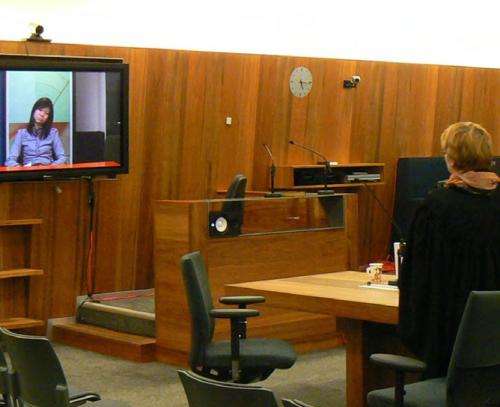Higher quality court videolinks will improve justice outcomes: study

Poor lighting, bad camera angles and technical glitches in videolink testimonies can affect justice outcomes in court, a new study has found, with researchers urging courts to adopt standardised videoconferencing guidelines.
The use of videoconferencing is on the rise in Australian courts, with over 50% of all court appearances for inmates in NSW last financial year occurring through videolink. Child and vulnerable witnesses also routinely give evidence via videolink.
The research team included experts from the University of Technology, Sydney, Edith Cowan University, the University of Western Sydney, the University of Canberra, Charles Sturt University, the University of Sydney and the University of Melbourne.
The team analysed the design of rooms used by remote witnesses, experts and defendants to give evidence remotely by videolink, including the way the camera was set up. They also studied what happens in the lead up to the videoconference and just after it concludes.
Over three years, the researchers visited courts, prisons and remote sites, interviewing judicial officers, lawyers, court staff, court administrators and architects.
Distorted image, poor audio
They found that the image of the remote participant is often distorted, there are difficulties with simulating eye-contact and that audio quality is often poor, with voices sounding unnatural and unclear.
"What we found in the study was that these technical glitches result in poorer communication between people involved in the case. For things like examination and cross-examination, good communication is really important," said report co-author Dr Emma Rowden, a Chancellor's Postdoctoral Research Fellow at the University of Technology, Sydney's School of Architecture.
"Poor design and a lack of adequate information can also affect peoples' behaviour in the remote space. People didn't always get a sense they were in court and that affected the impression they made on the people on the other side of the screen."
Dr Rowden gave one example in which the person giving a videolink testimony thought they were making eye contact with the lawyer, but to those in the courtroom, the remote person on the screen appeared to be looking away from the lawyer who was questioning them.
"It looked like the person was not really paying attention to the proceedings in the court. That affects the impression they make," she said.
"It's difficult to know what effect that poorer communication may have and it may vary from case to case. For some cases it may not be so much of an issue. But, at worst, it may mean the judge or the jury could misinterpret the remote participant's body language, and therefore, what is being said. That could affect justice outcomes in court, which is why adopting higher standards for video-mediated communications in court is so important."
Court documents presented by videolink can be hard to see, unless a document camera is used. The videolink equipment in the remote room is not always well integrated to the built environment, often appearing on a moveable trolley, the researchers found. The remote room is also often an uncomfortable, cramped space, without natural light, and the remote participant often has to sit there for many hours.
The team also conducted an experiment involving 170 mock jurors, 64 lay witnesses and 21 expert witnesses, and found that improving the quality of the videolink technology and the built environment vastly improved interaction between those appearing by video and those in the courtroom.
New guidelines
The researchers produced new guidelines recommending that the remote participant is always filmed in a space that is private and comfortable.
Court and judicial staff should be trained in the use of the technology and the video set-up "should always frame the remote participant in a way that gives the impression to those watching from the courtroom that the remote participant is being treated with dignity and respect, and that there is nothing distracting or diminishing the appearance of the remote participant," the report said.
Dr Rowden said that important features of nonverbal communication, such as eye-contact, are often difficult to simulate by videolink unless the design is carefully thought through.
"This research is significant because this is the first time that a holistic approach has been taken to the issue of videoconferencing and remote access to courts – not just looking at design issues, but also at court processes and protocols," said Dr Rowden.
Another co-author, Professor Anne Wallace, Head of the School of Law and Justice, Edith Cowan University, said that "the research demonstrates that while courts mightn't be able to always afford top-notch technology, they can still achieve better outcomes for participants by improving the way they use their existing technology, the environments that they operate in, and the information and support given to remote participants."
The expanded courtroom
Carolyn McKay, a PhD candidate at the School of Criminology at the University of Sydney whose research explores the impact of video technologies upon inmates, said the research was timely and important.
"The whole report acknowledges that there is a major paradigm shift occurring in legal process. We're moving away from corporeality and people actually sharing a physical space together to see justice being served. Now we have this major shift to a new model; we have an expanded site of justice," said Ms McKay, who was not involved in the study.
"Their experiments were really interesting. They compared a standard environment and standard process with an enhanced environment and an enhanced process and changed that around and had different variables. And they, not surprisingly, found that improving both the environment and the process created a much better interaction between all the participants."
Source: The Conversation
This story is published courtesy of The Conversation (under Creative Commons-Attribution/No derivatives).















